BTEC HND in Business: Aldi's Marketing Mix & Strategic Planning Report
VerifiedAdded on 2023/06/17
|19
|5682
|298
Report
AI Summary
This report provides an analysis of Aldi's marketing process and planning, focusing on the marketing concept, functions, and mix. It begins by defining marketing in the 21st century and describing the role of the marketing function within an organization, using Aldi as a primary example. The report analyzes how the marketing function interacts with other departments and explains the extended marketing mix (7Ps), evaluating its contribution to Aldi's overall business objectives. Key elements discussed include Aldi's competitive pricing strategy, omnichannel distribution system, diversified product portfolio, and promotional activities. The report further assesses how Aldi's strategic implementation of the marketing mix, particularly price, place, product, and promotion, supports its competitive position and customer engagement, ultimately driving business profitability and success. The document concludes with recommendations and a summary of findings.
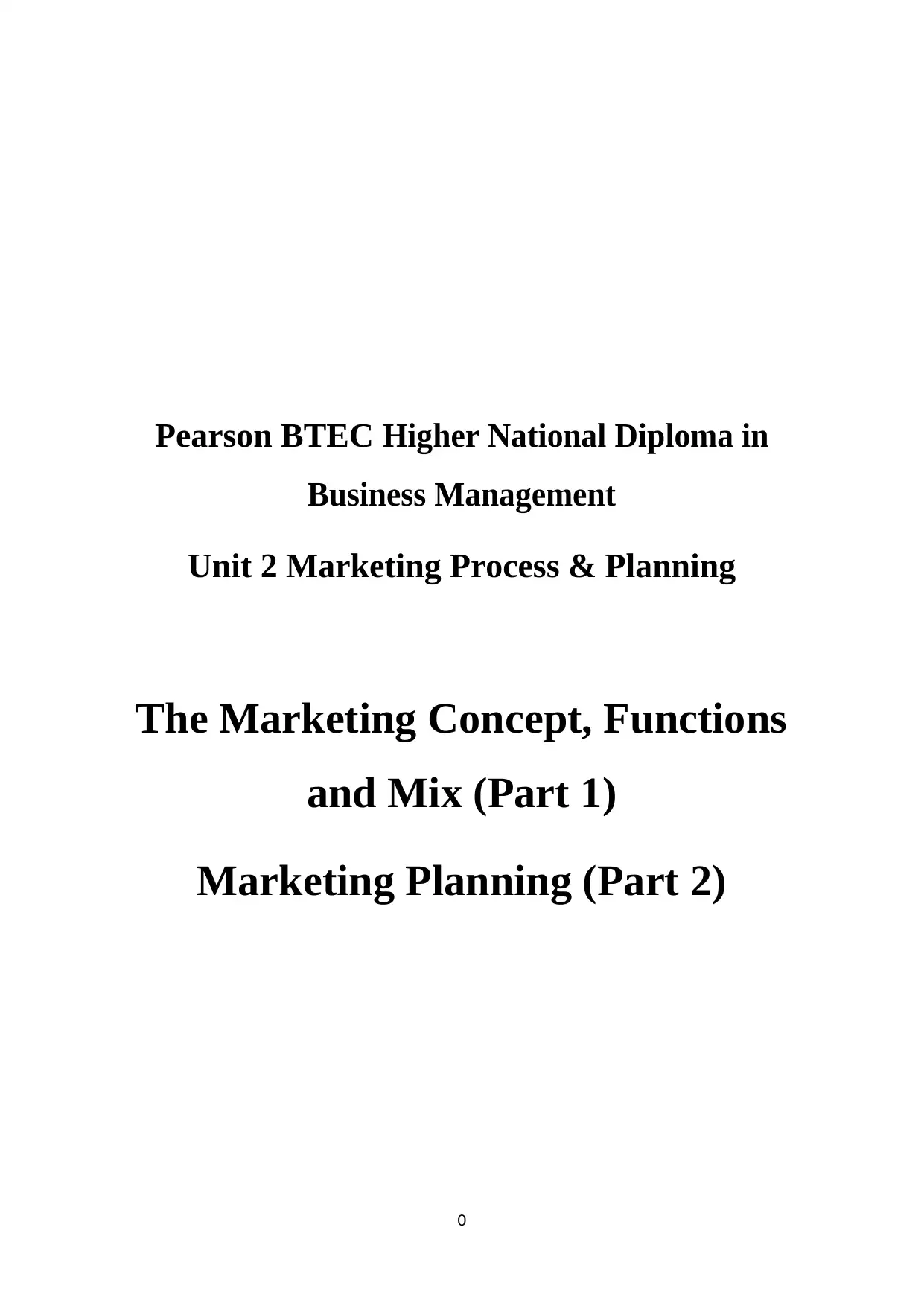
Pearson BTEC Higher National Diploma in
Business Management
Unit 2 Marketing Process & Planning
The Marketing Concept, Functions
and Mix (Part 1)
Marketing Planning (Part 2)
0
Business Management
Unit 2 Marketing Process & Planning
The Marketing Concept, Functions
and Mix (Part 1)
Marketing Planning (Part 2)
0
Paraphrase This Document
Need a fresh take? Get an instant paraphrase of this document with our AI Paraphraser
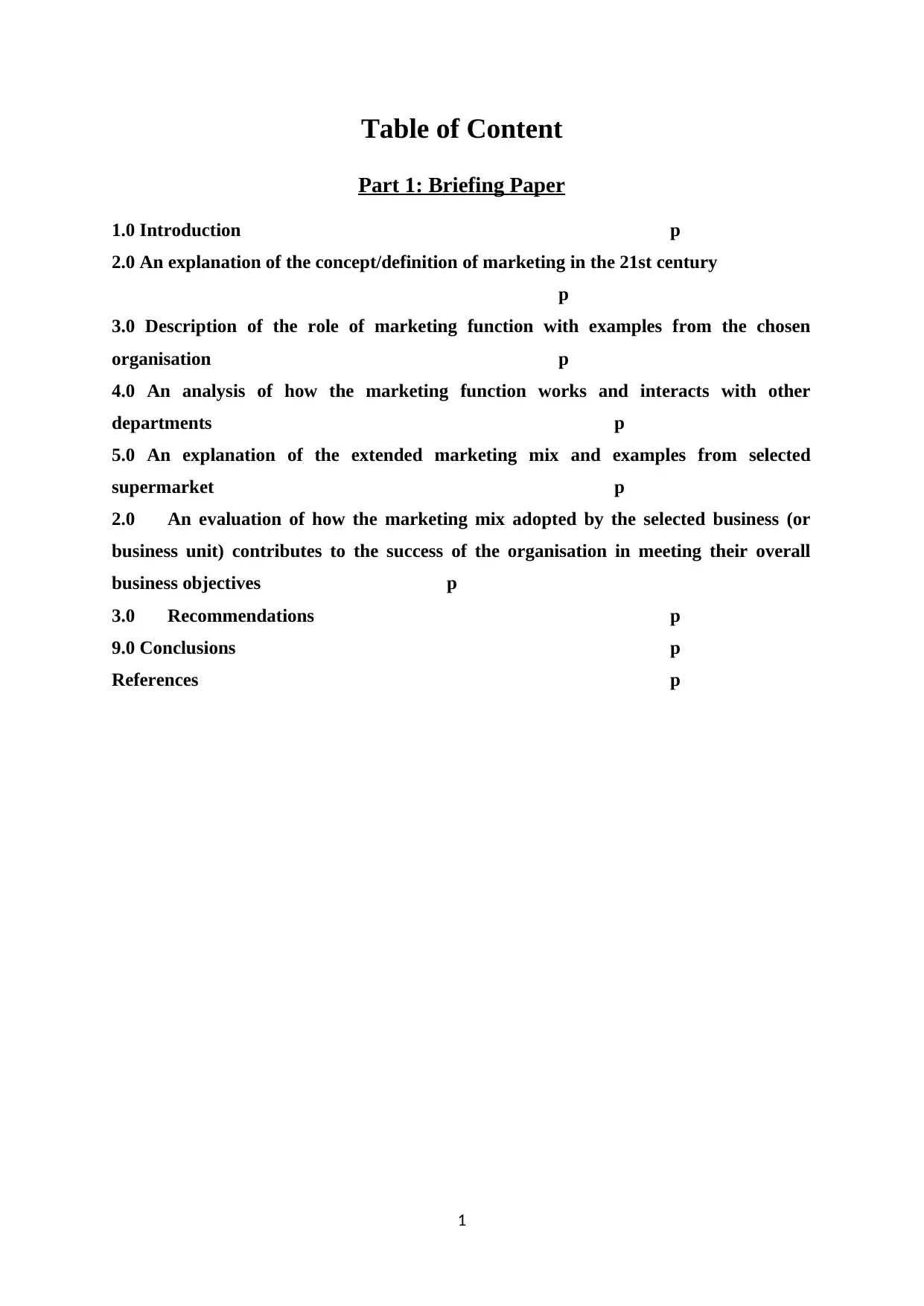
Table of Content
Part 1: Briefing Paper
1.0 Introduction p
2.0 An explanation of the concept/definition of marketing in the 21st century
p
3.0 Description of the role of marketing function with examples from the chosen
organisation p
4.0 An analysis of how the marketing function works and interacts with other
departments p
5.0 An explanation of the extended marketing mix and examples from selected
supermarket p
2.0 An evaluation of how the marketing mix adopted by the selected business (or
business unit) contributes to the success of the organisation in meeting their overall
business objectives p
3.0 Recommendations p
9.0 Conclusions p
References p
1
Part 1: Briefing Paper
1.0 Introduction p
2.0 An explanation of the concept/definition of marketing in the 21st century
p
3.0 Description of the role of marketing function with examples from the chosen
organisation p
4.0 An analysis of how the marketing function works and interacts with other
departments p
5.0 An explanation of the extended marketing mix and examples from selected
supermarket p
2.0 An evaluation of how the marketing mix adopted by the selected business (or
business unit) contributes to the success of the organisation in meeting their overall
business objectives p
3.0 Recommendations p
9.0 Conclusions p
References p
1
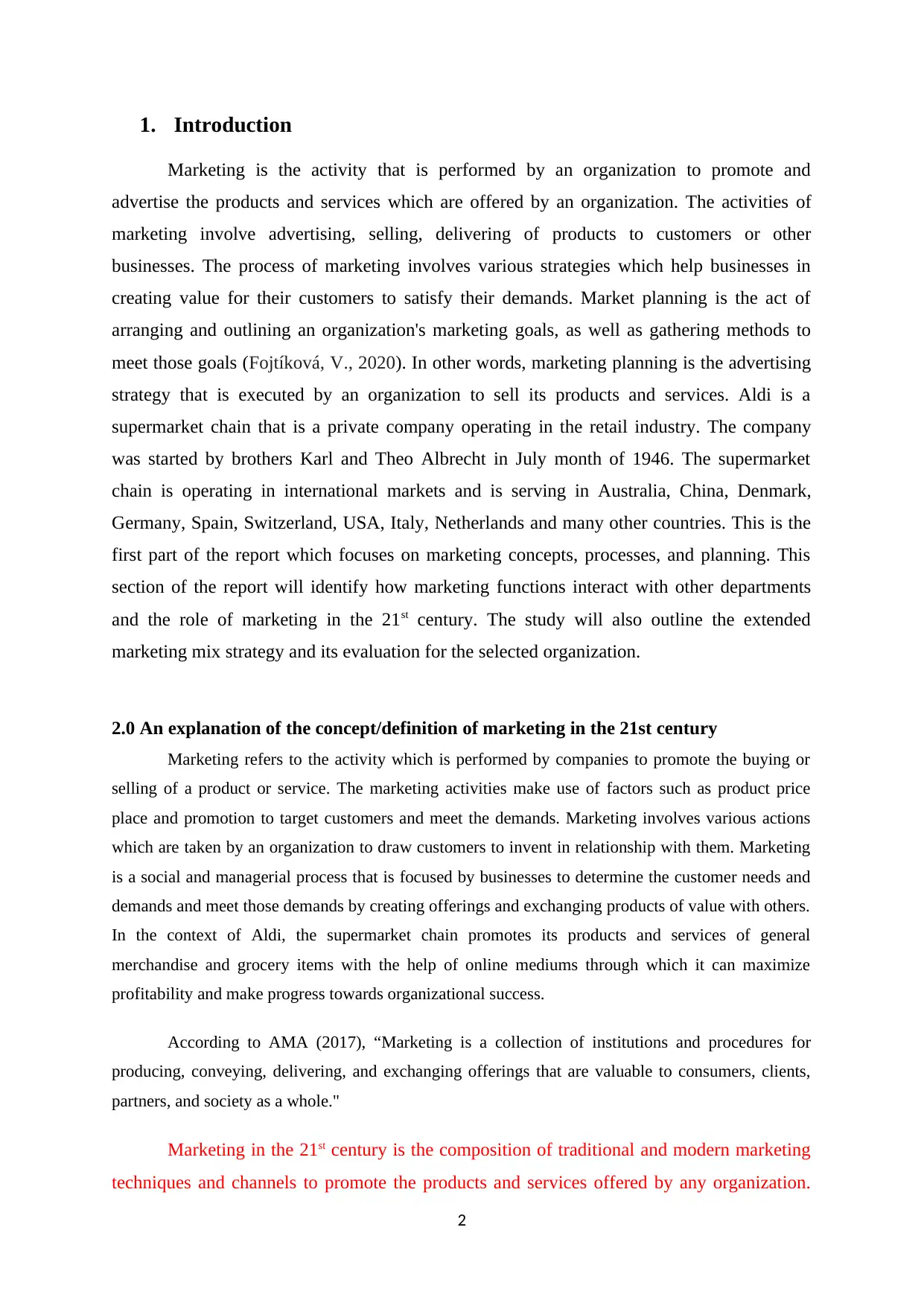
1. Introduction
Marketing is the activity that is performed by an organization to promote and
advertise the products and services which are offered by an organization. The activities of
marketing involve advertising, selling, delivering of products to customers or other
businesses. The process of marketing involves various strategies which help businesses in
creating value for their customers to satisfy their demands. Market planning is the act of
arranging and outlining an organization's marketing goals, as well as gathering methods to
meet those goals (Fojtíková, V., 2020). In other words, marketing planning is the advertising
strategy that is executed by an organization to sell its products and services. Aldi is a
supermarket chain that is a private company operating in the retail industry. The company
was started by brothers Karl and Theo Albrecht in July month of 1946. The supermarket
chain is operating in international markets and is serving in Australia, China, Denmark,
Germany, Spain, Switzerland, USA, Italy, Netherlands and many other countries. This is the
first part of the report which focuses on marketing concepts, processes, and planning. This
section of the report will identify how marketing functions interact with other departments
and the role of marketing in the 21st century. The study will also outline the extended
marketing mix strategy and its evaluation for the selected organization.
2.0 An explanation of the concept/definition of marketing in the 21st century
Marketing refers to the activity which is performed by companies to promote the buying or
selling of a product or service. The marketing activities make use of factors such as product price
place and promotion to target customers and meet the demands. Marketing involves various actions
which are taken by an organization to draw customers to invent in relationship with them. Marketing
is a social and managerial process that is focused by businesses to determine the customer needs and
demands and meet those demands by creating offerings and exchanging products of value with others.
In the context of Aldi, the supermarket chain promotes its products and services of general
merchandise and grocery items with the help of online mediums through which it can maximize
profitability and make progress towards organizational success.
According to AMA (2017), “Marketing is a collection of institutions and procedures for
producing, conveying, delivering, and exchanging offerings that are valuable to consumers, clients,
partners, and society as a whole."
Marketing in the 21st century is the composition of traditional and modern marketing
techniques and channels to promote the products and services offered by any organization.
2
Marketing is the activity that is performed by an organization to promote and
advertise the products and services which are offered by an organization. The activities of
marketing involve advertising, selling, delivering of products to customers or other
businesses. The process of marketing involves various strategies which help businesses in
creating value for their customers to satisfy their demands. Market planning is the act of
arranging and outlining an organization's marketing goals, as well as gathering methods to
meet those goals (Fojtíková, V., 2020). In other words, marketing planning is the advertising
strategy that is executed by an organization to sell its products and services. Aldi is a
supermarket chain that is a private company operating in the retail industry. The company
was started by brothers Karl and Theo Albrecht in July month of 1946. The supermarket
chain is operating in international markets and is serving in Australia, China, Denmark,
Germany, Spain, Switzerland, USA, Italy, Netherlands and many other countries. This is the
first part of the report which focuses on marketing concepts, processes, and planning. This
section of the report will identify how marketing functions interact with other departments
and the role of marketing in the 21st century. The study will also outline the extended
marketing mix strategy and its evaluation for the selected organization.
2.0 An explanation of the concept/definition of marketing in the 21st century
Marketing refers to the activity which is performed by companies to promote the buying or
selling of a product or service. The marketing activities make use of factors such as product price
place and promotion to target customers and meet the demands. Marketing involves various actions
which are taken by an organization to draw customers to invent in relationship with them. Marketing
is a social and managerial process that is focused by businesses to determine the customer needs and
demands and meet those demands by creating offerings and exchanging products of value with others.
In the context of Aldi, the supermarket chain promotes its products and services of general
merchandise and grocery items with the help of online mediums through which it can maximize
profitability and make progress towards organizational success.
According to AMA (2017), “Marketing is a collection of institutions and procedures for
producing, conveying, delivering, and exchanging offerings that are valuable to consumers, clients,
partners, and society as a whole."
Marketing in the 21st century is the composition of traditional and modern marketing
techniques and channels to promote the products and services offered by any organization.
2
⊘ This is a preview!⊘
Do you want full access?
Subscribe today to unlock all pages.

Trusted by 1+ million students worldwide
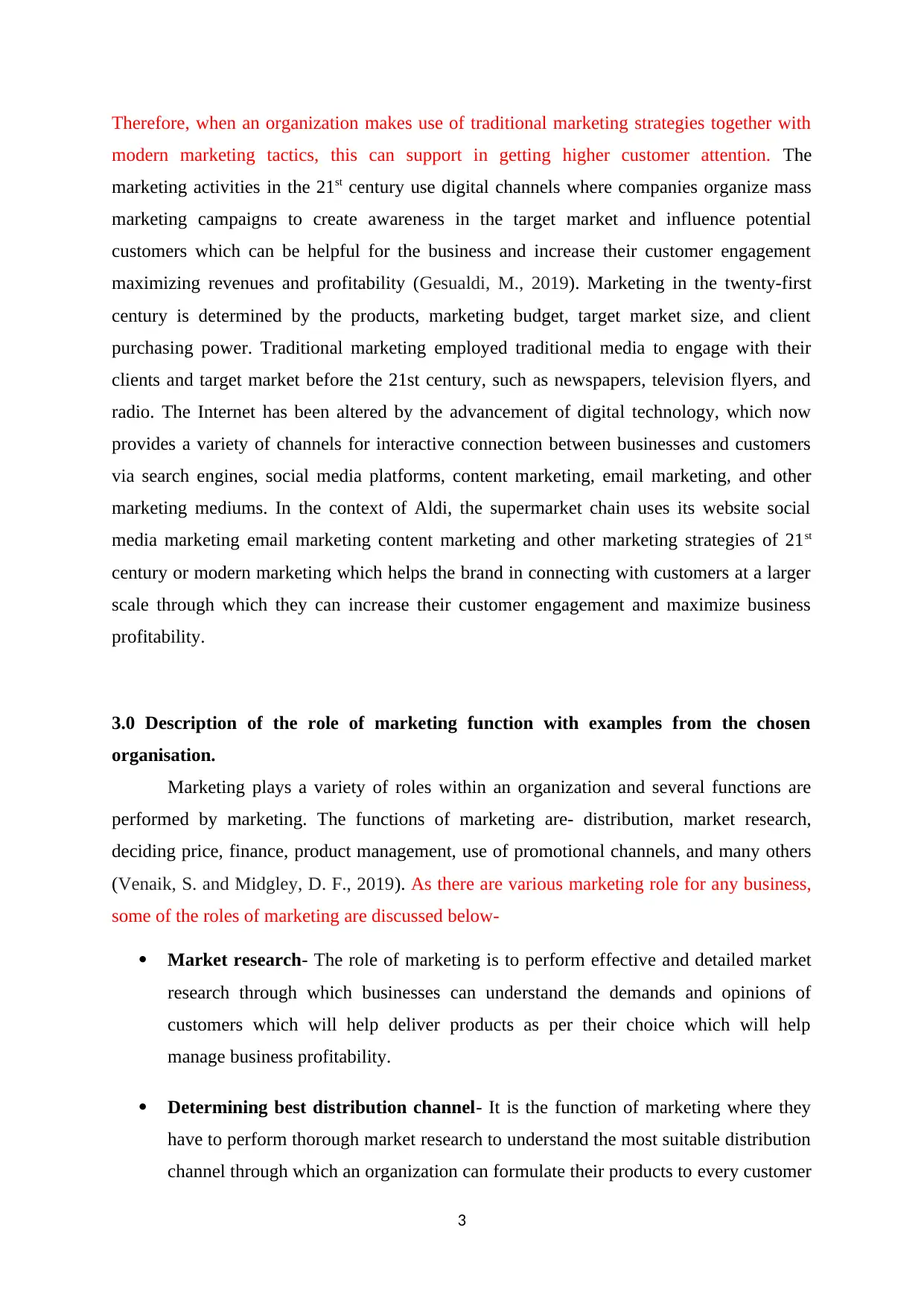
Therefore, when an organization makes use of traditional marketing strategies together with
modern marketing tactics, this can support in getting higher customer attention. The
marketing activities in the 21st century use digital channels where companies organize mass
marketing campaigns to create awareness in the target market and influence potential
customers which can be helpful for the business and increase their customer engagement
maximizing revenues and profitability (Gesualdi, M., 2019). Marketing in the twenty-first
century is determined by the products, marketing budget, target market size, and client
purchasing power. Traditional marketing employed traditional media to engage with their
clients and target market before the 21st century, such as newspapers, television flyers, and
radio. The Internet has been altered by the advancement of digital technology, which now
provides a variety of channels for interactive connection between businesses and customers
via search engines, social media platforms, content marketing, email marketing, and other
marketing mediums. In the context of Aldi, the supermarket chain uses its website social
media marketing email marketing content marketing and other marketing strategies of 21st
century or modern marketing which helps the brand in connecting with customers at a larger
scale through which they can increase their customer engagement and maximize business
profitability.
3.0 Description of the role of marketing function with examples from the chosen
organisation.
Marketing plays a variety of roles within an organization and several functions are
performed by marketing. The functions of marketing are- distribution, market research,
deciding price, finance, product management, use of promotional channels, and many others
(Venaik, S. and Midgley, D. F., 2019). As there are various marketing role for any business,
some of the roles of marketing are discussed below-
Market research- The role of marketing is to perform effective and detailed market
research through which businesses can understand the demands and opinions of
customers which will help deliver products as per their choice which will help
manage business profitability.
Determining best distribution channel- It is the function of marketing where they
have to perform thorough market research to understand the most suitable distribution
channel through which an organization can formulate their products to every customer
3
modern marketing tactics, this can support in getting higher customer attention. The
marketing activities in the 21st century use digital channels where companies organize mass
marketing campaigns to create awareness in the target market and influence potential
customers which can be helpful for the business and increase their customer engagement
maximizing revenues and profitability (Gesualdi, M., 2019). Marketing in the twenty-first
century is determined by the products, marketing budget, target market size, and client
purchasing power. Traditional marketing employed traditional media to engage with their
clients and target market before the 21st century, such as newspapers, television flyers, and
radio. The Internet has been altered by the advancement of digital technology, which now
provides a variety of channels for interactive connection between businesses and customers
via search engines, social media platforms, content marketing, email marketing, and other
marketing mediums. In the context of Aldi, the supermarket chain uses its website social
media marketing email marketing content marketing and other marketing strategies of 21st
century or modern marketing which helps the brand in connecting with customers at a larger
scale through which they can increase their customer engagement and maximize business
profitability.
3.0 Description of the role of marketing function with examples from the chosen
organisation.
Marketing plays a variety of roles within an organization and several functions are
performed by marketing. The functions of marketing are- distribution, market research,
deciding price, finance, product management, use of promotional channels, and many others
(Venaik, S. and Midgley, D. F., 2019). As there are various marketing role for any business,
some of the roles of marketing are discussed below-
Market research- The role of marketing is to perform effective and detailed market
research through which businesses can understand the demands and opinions of
customers which will help deliver products as per their choice which will help
manage business profitability.
Determining best distribution channel- It is the function of marketing where they
have to perform thorough market research to understand the most suitable distribution
channel through which an organization can formulate their products to every customer
3
Paraphrase This Document
Need a fresh take? Get an instant paraphrase of this document with our AI Paraphraser
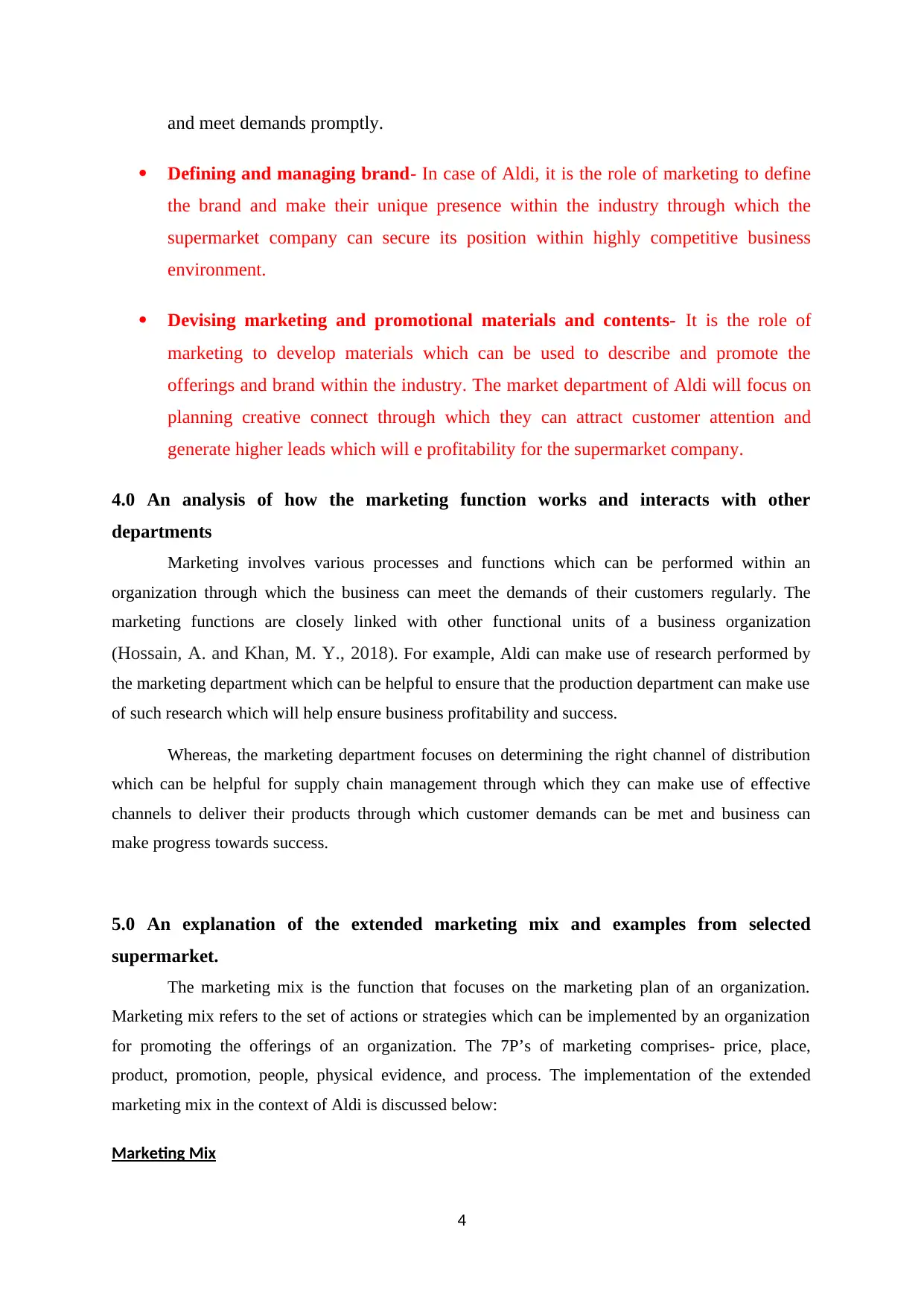
and meet demands promptly.
Defining and managing brand- In case of Aldi, it is the role of marketing to define
the brand and make their unique presence within the industry through which the
supermarket company can secure its position within highly competitive business
environment.
Devising marketing and promotional materials and contents- It is the role of
marketing to develop materials which can be used to describe and promote the
offerings and brand within the industry. The market department of Aldi will focus on
planning creative connect through which they can attract customer attention and
generate higher leads which will e profitability for the supermarket company.
4.0 An analysis of how the marketing function works and interacts with other
departments
Marketing involves various processes and functions which can be performed within an
organization through which the business can meet the demands of their customers regularly. The
marketing functions are closely linked with other functional units of a business organization
(Hossain, A. and Khan, M. Y., 2018). For example, Aldi can make use of research performed by
the marketing department which can be helpful to ensure that the production department can make use
of such research which will help ensure business profitability and success.
Whereas, the marketing department focuses on determining the right channel of distribution
which can be helpful for supply chain management through which they can make use of effective
channels to deliver their products through which customer demands can be met and business can
make progress towards success.
5.0 An explanation of the extended marketing mix and examples from selected
supermarket.
The marketing mix is the function that focuses on the marketing plan of an organization.
Marketing mix refers to the set of actions or strategies which can be implemented by an organization
for promoting the offerings of an organization. The 7P’s of marketing comprises- price, place,
product, promotion, people, physical evidence, and process. The implementation of the extended
marketing mix in the context of Aldi is discussed below:
Marketing Mix
4
Defining and managing brand- In case of Aldi, it is the role of marketing to define
the brand and make their unique presence within the industry through which the
supermarket company can secure its position within highly competitive business
environment.
Devising marketing and promotional materials and contents- It is the role of
marketing to develop materials which can be used to describe and promote the
offerings and brand within the industry. The market department of Aldi will focus on
planning creative connect through which they can attract customer attention and
generate higher leads which will e profitability for the supermarket company.
4.0 An analysis of how the marketing function works and interacts with other
departments
Marketing involves various processes and functions which can be performed within an
organization through which the business can meet the demands of their customers regularly. The
marketing functions are closely linked with other functional units of a business organization
(Hossain, A. and Khan, M. Y., 2018). For example, Aldi can make use of research performed by
the marketing department which can be helpful to ensure that the production department can make use
of such research which will help ensure business profitability and success.
Whereas, the marketing department focuses on determining the right channel of distribution
which can be helpful for supply chain management through which they can make use of effective
channels to deliver their products through which customer demands can be met and business can
make progress towards success.
5.0 An explanation of the extended marketing mix and examples from selected
supermarket.
The marketing mix is the function that focuses on the marketing plan of an organization.
Marketing mix refers to the set of actions or strategies which can be implemented by an organization
for promoting the offerings of an organization. The 7P’s of marketing comprises- price, place,
product, promotion, people, physical evidence, and process. The implementation of the extended
marketing mix in the context of Aldi is discussed below:
Marketing Mix
4
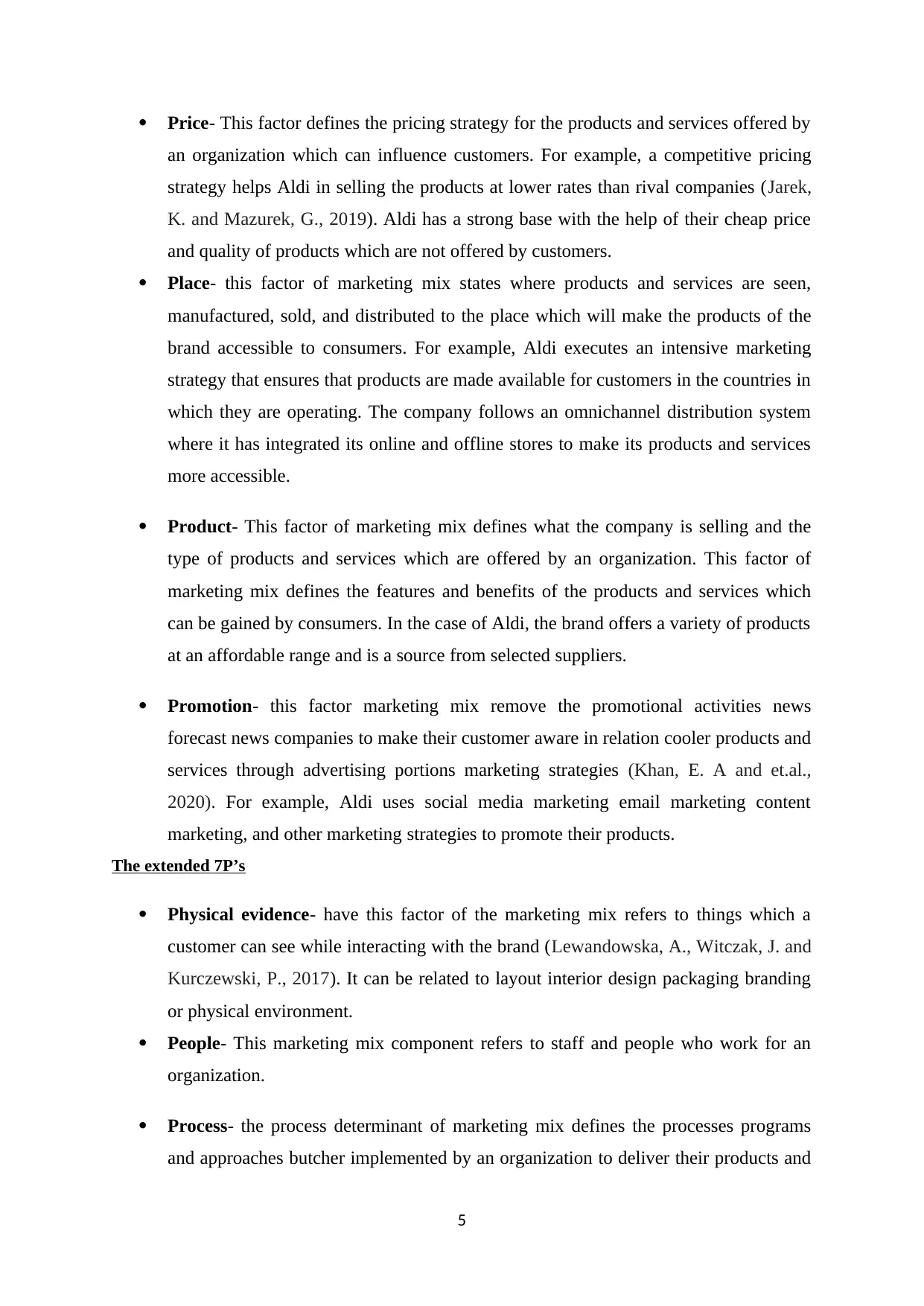
Price- This factor defines the pricing strategy for the products and services offered by
an organization which can influence customers. For example, a competitive pricing
strategy helps Aldi in selling the products at lower rates than rival companies (Jarek,
K. and Mazurek, G., 2019). Aldi has a strong base with the help of their cheap price
and quality of products which are not offered by customers.
Place- this factor of marketing mix states where products and services are seen,
manufactured, sold, and distributed to the place which will make the products of the
brand accessible to consumers. For example, Aldi executes an intensive marketing
strategy that ensures that products are made available for customers in the countries in
which they are operating. The company follows an omnichannel distribution system
where it has integrated its online and offline stores to make its products and services
more accessible.
Product- This factor of marketing mix defines what the company is selling and the
type of products and services which are offered by an organization. This factor of
marketing mix defines the features and benefits of the products and services which
can be gained by consumers. In the case of Aldi, the brand offers a variety of products
at an affordable range and is a source from selected suppliers.
Promotion- this factor marketing mix remove the promotional activities news
forecast news companies to make their customer aware in relation cooler products and
services through advertising portions marketing strategies (Khan, E. A and et.al.,
2020). For example, Aldi uses social media marketing email marketing content
marketing, and other marketing strategies to promote their products.
The extended 7P’s
Physical evidence- have this factor of the marketing mix refers to things which a
customer can see while interacting with the brand (Lewandowska, A., Witczak, J. and
Kurczewski, P., 2017). It can be related to layout interior design packaging branding
or physical environment.
People- This marketing mix component refers to staff and people who work for an
organization.
Process- the process determinant of marketing mix defines the processes programs
and approaches butcher implemented by an organization to deliver their products and
5
an organization which can influence customers. For example, a competitive pricing
strategy helps Aldi in selling the products at lower rates than rival companies (Jarek,
K. and Mazurek, G., 2019). Aldi has a strong base with the help of their cheap price
and quality of products which are not offered by customers.
Place- this factor of marketing mix states where products and services are seen,
manufactured, sold, and distributed to the place which will make the products of the
brand accessible to consumers. For example, Aldi executes an intensive marketing
strategy that ensures that products are made available for customers in the countries in
which they are operating. The company follows an omnichannel distribution system
where it has integrated its online and offline stores to make its products and services
more accessible.
Product- This factor of marketing mix defines what the company is selling and the
type of products and services which are offered by an organization. This factor of
marketing mix defines the features and benefits of the products and services which
can be gained by consumers. In the case of Aldi, the brand offers a variety of products
at an affordable range and is a source from selected suppliers.
Promotion- this factor marketing mix remove the promotional activities news
forecast news companies to make their customer aware in relation cooler products and
services through advertising portions marketing strategies (Khan, E. A and et.al.,
2020). For example, Aldi uses social media marketing email marketing content
marketing, and other marketing strategies to promote their products.
The extended 7P’s
Physical evidence- have this factor of the marketing mix refers to things which a
customer can see while interacting with the brand (Lewandowska, A., Witczak, J. and
Kurczewski, P., 2017). It can be related to layout interior design packaging branding
or physical environment.
People- This marketing mix component refers to staff and people who work for an
organization.
Process- the process determinant of marketing mix defines the processes programs
and approaches butcher implemented by an organization to deliver their products and
5
⊘ This is a preview!⊘
Do you want full access?
Subscribe today to unlock all pages.

Trusted by 1+ million students worldwide
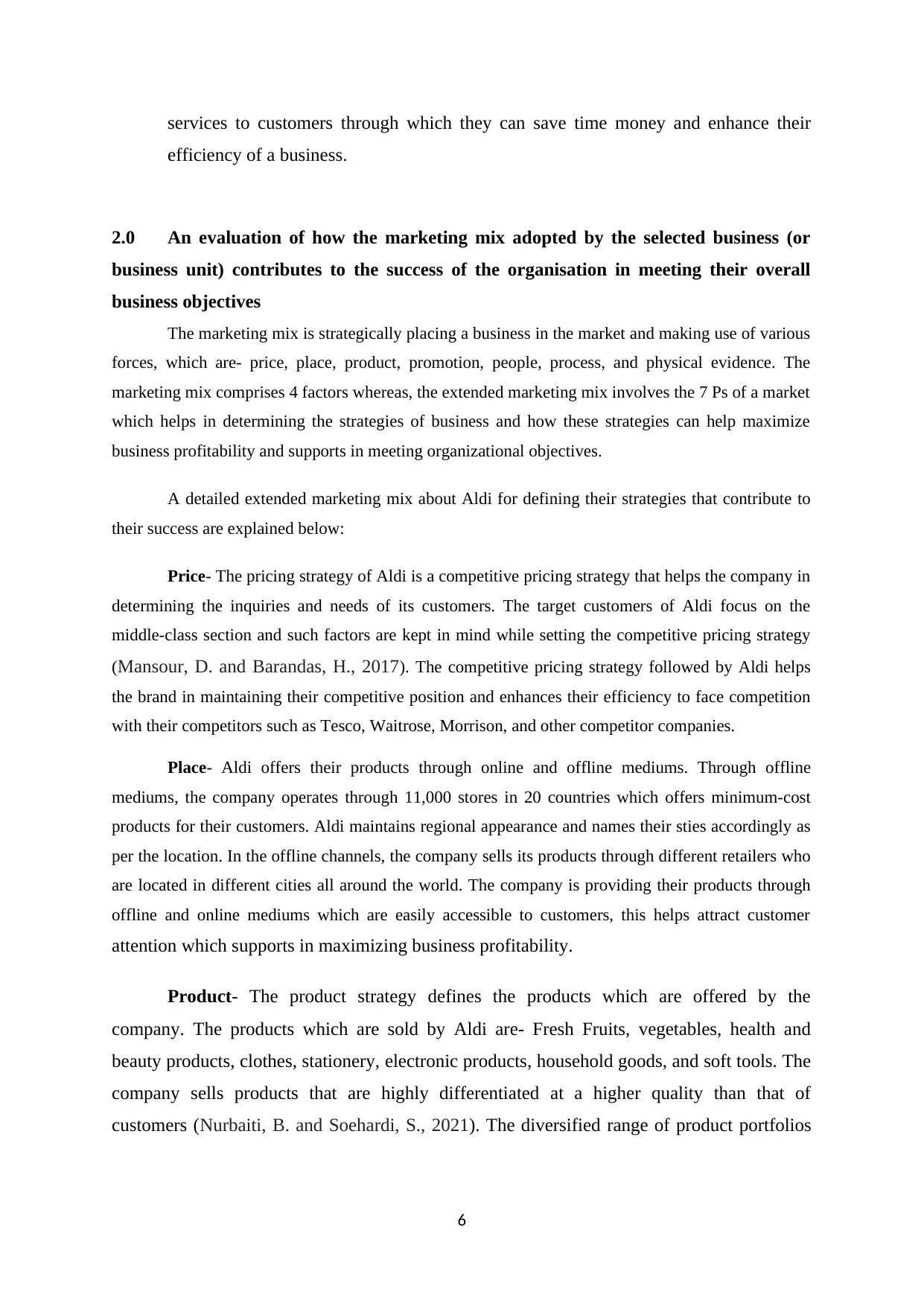
services to customers through which they can save time money and enhance their
efficiency of a business.
2.0 An evaluation of how the marketing mix adopted by the selected business (or
business unit) contributes to the success of the organisation in meeting their overall
business objectives
The marketing mix is strategically placing a business in the market and making use of various
forces, which are- price, place, product, promotion, people, process, and physical evidence. The
marketing mix comprises 4 factors whereas, the extended marketing mix involves the 7 Ps of a market
which helps in determining the strategies of business and how these strategies can help maximize
business profitability and supports in meeting organizational objectives.
A detailed extended marketing mix about Aldi for defining their strategies that contribute to
their success are explained below:
Price- The pricing strategy of Aldi is a competitive pricing strategy that helps the company in
determining the inquiries and needs of its customers. The target customers of Aldi focus on the
middle-class section and such factors are kept in mind while setting the competitive pricing strategy
(Mansour, D. and Barandas, H., 2017). The competitive pricing strategy followed by Aldi helps
the brand in maintaining their competitive position and enhances their efficiency to face competition
with their competitors such as Tesco, Waitrose, Morrison, and other competitor companies.
Place- Aldi offers their products through online and offline mediums. Through offline
mediums, the company operates through 11,000 stores in 20 countries which offers minimum-cost
products for their customers. Aldi maintains regional appearance and names their sties accordingly as
per the location. In the offline channels, the company sells its products through different retailers who
are located in different cities all around the world. The company is providing their products through
offline and online mediums which are easily accessible to customers, this helps attract customer
attention which supports in maximizing business profitability.
Product- The product strategy defines the products which are offered by the
company. The products which are sold by Aldi are- Fresh Fruits, vegetables, health and
beauty products, clothes, stationery, electronic products, household goods, and soft tools. The
company sells products that are highly differentiated at a higher quality than that of
customers (Nurbaiti, B. and Soehardi, S., 2021). The diversified range of product portfolios
6
efficiency of a business.
2.0 An evaluation of how the marketing mix adopted by the selected business (or
business unit) contributes to the success of the organisation in meeting their overall
business objectives
The marketing mix is strategically placing a business in the market and making use of various
forces, which are- price, place, product, promotion, people, process, and physical evidence. The
marketing mix comprises 4 factors whereas, the extended marketing mix involves the 7 Ps of a market
which helps in determining the strategies of business and how these strategies can help maximize
business profitability and supports in meeting organizational objectives.
A detailed extended marketing mix about Aldi for defining their strategies that contribute to
their success are explained below:
Price- The pricing strategy of Aldi is a competitive pricing strategy that helps the company in
determining the inquiries and needs of its customers. The target customers of Aldi focus on the
middle-class section and such factors are kept in mind while setting the competitive pricing strategy
(Mansour, D. and Barandas, H., 2017). The competitive pricing strategy followed by Aldi helps
the brand in maintaining their competitive position and enhances their efficiency to face competition
with their competitors such as Tesco, Waitrose, Morrison, and other competitor companies.
Place- Aldi offers their products through online and offline mediums. Through offline
mediums, the company operates through 11,000 stores in 20 countries which offers minimum-cost
products for their customers. Aldi maintains regional appearance and names their sties accordingly as
per the location. In the offline channels, the company sells its products through different retailers who
are located in different cities all around the world. The company is providing their products through
offline and online mediums which are easily accessible to customers, this helps attract customer
attention which supports in maximizing business profitability.
Product- The product strategy defines the products which are offered by the
company. The products which are sold by Aldi are- Fresh Fruits, vegetables, health and
beauty products, clothes, stationery, electronic products, household goods, and soft tools. The
company sells products that are highly differentiated at a higher quality than that of
customers (Nurbaiti, B. and Soehardi, S., 2021). The diversified range of product portfolios
6
Paraphrase This Document
Need a fresh take? Get an instant paraphrase of this document with our AI Paraphraser
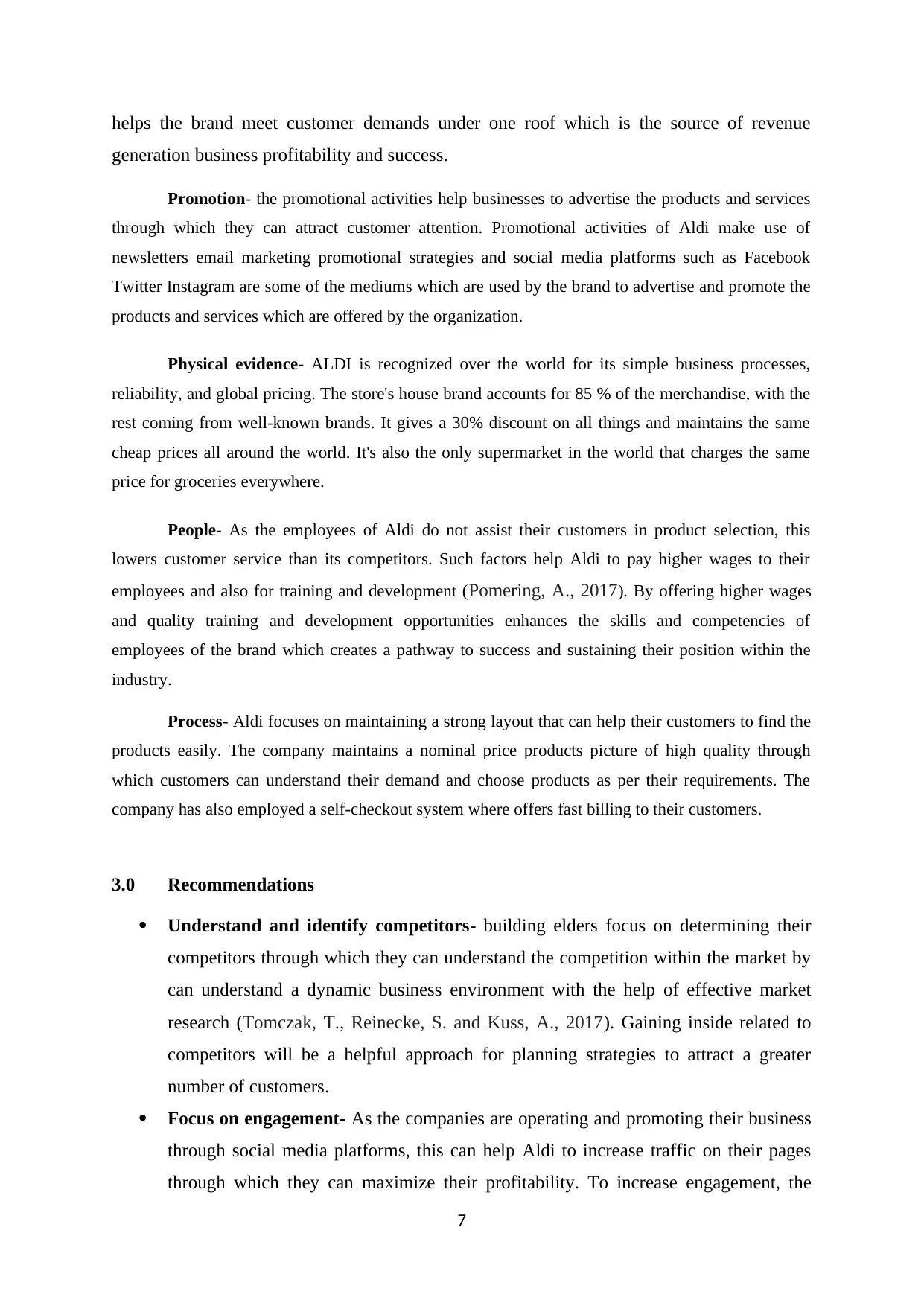
helps the brand meet customer demands under one roof which is the source of revenue
generation business profitability and success.
Promotion- the promotional activities help businesses to advertise the products and services
through which they can attract customer attention. Promotional activities of Aldi make use of
newsletters email marketing promotional strategies and social media platforms such as Facebook
Twitter Instagram are some of the mediums which are used by the brand to advertise and promote the
products and services which are offered by the organization.
Physical evidence- ALDI is recognized over the world for its simple business processes,
reliability, and global pricing. The store's house brand accounts for 85 % of the merchandise, with the
rest coming from well-known brands. It gives a 30% discount on all things and maintains the same
cheap prices all around the world. It's also the only supermarket in the world that charges the same
price for groceries everywhere.
People- As the employees of Aldi do not assist their customers in product selection, this
lowers customer service than its competitors. Such factors help Aldi to pay higher wages to their
employees and also for training and development (Pomering, A., 2017). By offering higher wages
and quality training and development opportunities enhances the skills and competencies of
employees of the brand which creates a pathway to success and sustaining their position within the
industry.
Process- Aldi focuses on maintaining a strong layout that can help their customers to find the
products easily. The company maintains a nominal price products picture of high quality through
which customers can understand their demand and choose products as per their requirements. The
company has also employed a self-checkout system where offers fast billing to their customers.
3.0 Recommendations
Understand and identify competitors- building elders focus on determining their
competitors through which they can understand the competition within the market by
can understand a dynamic business environment with the help of effective market
research (Tomczak, T., Reinecke, S. and Kuss, A., 2017). Gaining inside related to
competitors will be a helpful approach for planning strategies to attract a greater
number of customers.
Focus on engagement- As the companies are operating and promoting their business
through social media platforms, this can help Aldi to increase traffic on their pages
through which they can maximize their profitability. To increase engagement, the
7
generation business profitability and success.
Promotion- the promotional activities help businesses to advertise the products and services
through which they can attract customer attention. Promotional activities of Aldi make use of
newsletters email marketing promotional strategies and social media platforms such as Facebook
Twitter Instagram are some of the mediums which are used by the brand to advertise and promote the
products and services which are offered by the organization.
Physical evidence- ALDI is recognized over the world for its simple business processes,
reliability, and global pricing. The store's house brand accounts for 85 % of the merchandise, with the
rest coming from well-known brands. It gives a 30% discount on all things and maintains the same
cheap prices all around the world. It's also the only supermarket in the world that charges the same
price for groceries everywhere.
People- As the employees of Aldi do not assist their customers in product selection, this
lowers customer service than its competitors. Such factors help Aldi to pay higher wages to their
employees and also for training and development (Pomering, A., 2017). By offering higher wages
and quality training and development opportunities enhances the skills and competencies of
employees of the brand which creates a pathway to success and sustaining their position within the
industry.
Process- Aldi focuses on maintaining a strong layout that can help their customers to find the
products easily. The company maintains a nominal price products picture of high quality through
which customers can understand their demand and choose products as per their requirements. The
company has also employed a self-checkout system where offers fast billing to their customers.
3.0 Recommendations
Understand and identify competitors- building elders focus on determining their
competitors through which they can understand the competition within the market by
can understand a dynamic business environment with the help of effective market
research (Tomczak, T., Reinecke, S. and Kuss, A., 2017). Gaining inside related to
competitors will be a helpful approach for planning strategies to attract a greater
number of customers.
Focus on engagement- As the companies are operating and promoting their business
through social media platforms, this can help Aldi to increase traffic on their pages
through which they can maximize their profitability. To increase engagement, the
7
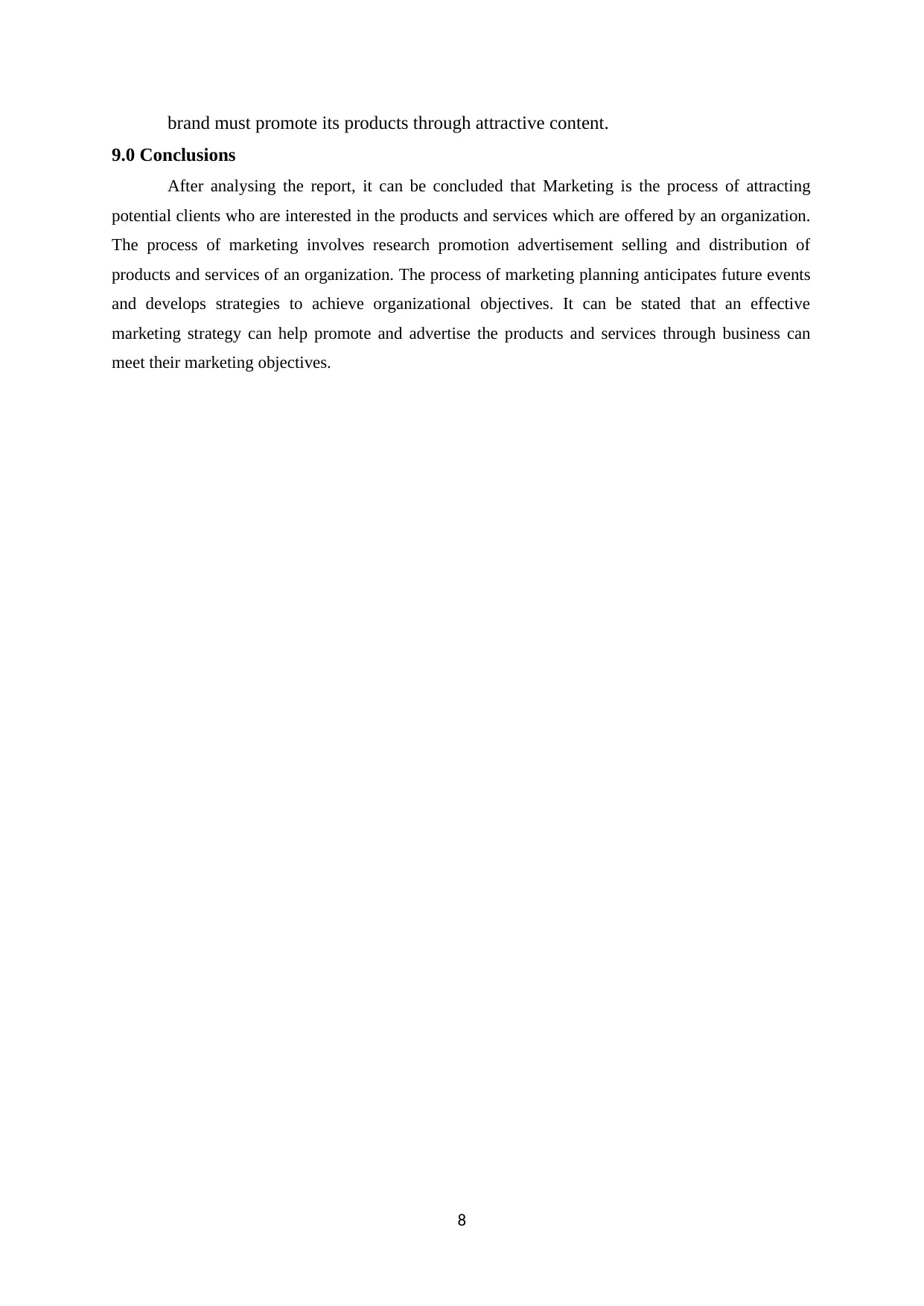
brand must promote its products through attractive content.
9.0 Conclusions
After analysing the report, it can be concluded that Marketing is the process of attracting
potential clients who are interested in the products and services which are offered by an organization.
The process of marketing involves research promotion advertisement selling and distribution of
products and services of an organization. The process of marketing planning anticipates future events
and develops strategies to achieve organizational objectives. It can be stated that an effective
marketing strategy can help promote and advertise the products and services through business can
meet their marketing objectives.
8
9.0 Conclusions
After analysing the report, it can be concluded that Marketing is the process of attracting
potential clients who are interested in the products and services which are offered by an organization.
The process of marketing involves research promotion advertisement selling and distribution of
products and services of an organization. The process of marketing planning anticipates future events
and develops strategies to achieve organizational objectives. It can be stated that an effective
marketing strategy can help promote and advertise the products and services through business can
meet their marketing objectives.
8
⊘ This is a preview!⊘
Do you want full access?
Subscribe today to unlock all pages.

Trusted by 1+ million students worldwide
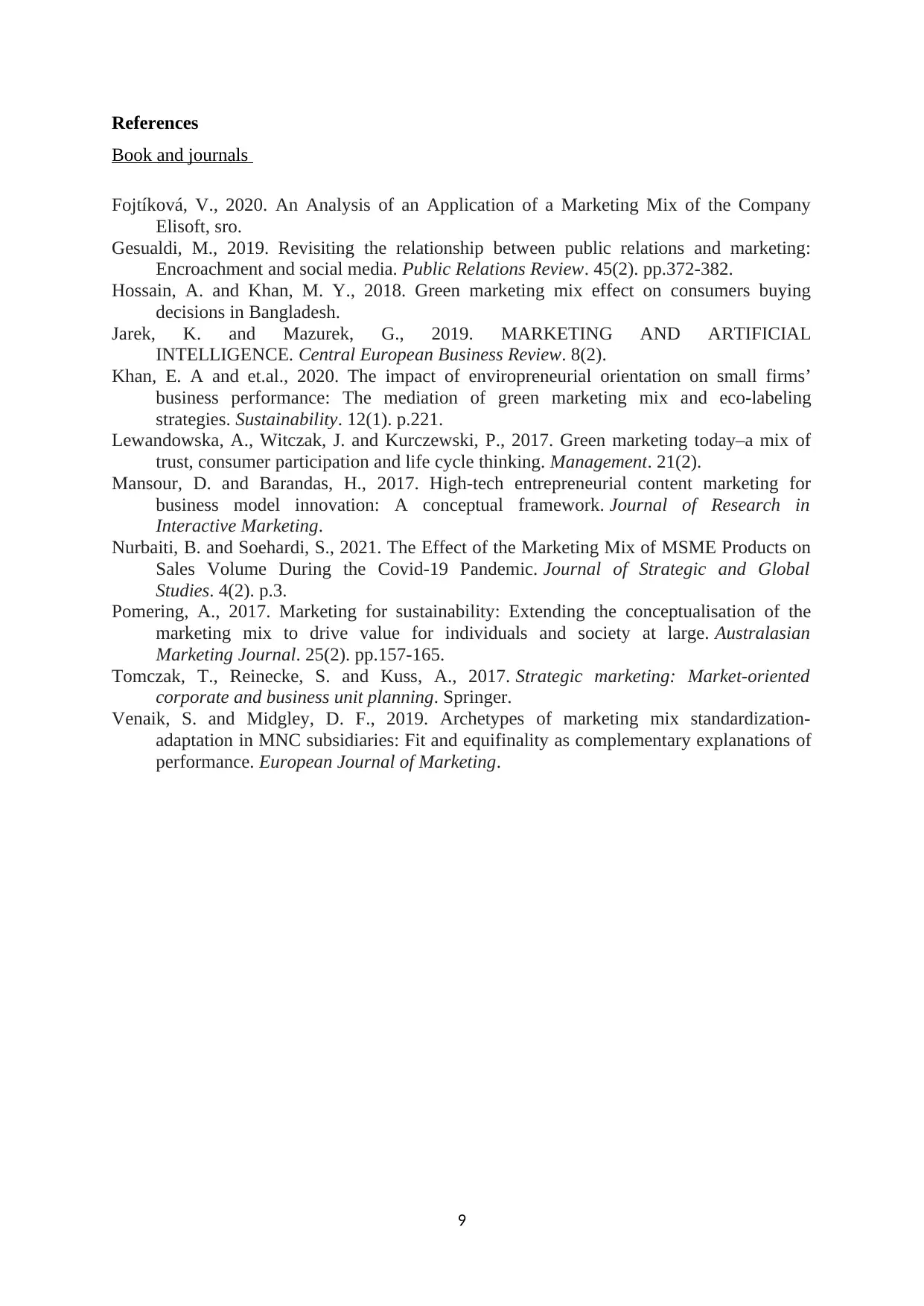
References
Book and journals
Fojtíková, V., 2020. An Analysis of an Application of a Marketing Mix of the Company
Elisoft, sro.
Gesualdi, M., 2019. Revisiting the relationship between public relations and marketing:
Encroachment and social media. Public Relations Review. 45(2). pp.372-382.
Hossain, A. and Khan, M. Y., 2018. Green marketing mix effect on consumers buying
decisions in Bangladesh.
Jarek, K. and Mazurek, G., 2019. MARKETING AND ARTIFICIAL
INTELLIGENCE. Central European Business Review. 8(2).
Khan, E. A and et.al., 2020. The impact of enviropreneurial orientation on small firms’
business performance: The mediation of green marketing mix and eco-labeling
strategies. Sustainability. 12(1). p.221.
Lewandowska, A., Witczak, J. and Kurczewski, P., 2017. Green marketing today–a mix of
trust, consumer participation and life cycle thinking. Management. 21(2).
Mansour, D. and Barandas, H., 2017. High-tech entrepreneurial content marketing for
business model innovation: A conceptual framework. Journal of Research in
Interactive Marketing.
Nurbaiti, B. and Soehardi, S., 2021. The Effect of the Marketing Mix of MSME Products on
Sales Volume During the Covid-19 Pandemic. Journal of Strategic and Global
Studies. 4(2). p.3.
Pomering, A., 2017. Marketing for sustainability: Extending the conceptualisation of the
marketing mix to drive value for individuals and society at large. Australasian
Marketing Journal. 25(2). pp.157-165.
Tomczak, T., Reinecke, S. and Kuss, A., 2017. Strategic marketing: Market-oriented
corporate and business unit planning. Springer.
Venaik, S. and Midgley, D. F., 2019. Archetypes of marketing mix standardization-
adaptation in MNC subsidiaries: Fit and equifinality as complementary explanations of
performance. European Journal of Marketing.
9
Book and journals
Fojtíková, V., 2020. An Analysis of an Application of a Marketing Mix of the Company
Elisoft, sro.
Gesualdi, M., 2019. Revisiting the relationship between public relations and marketing:
Encroachment and social media. Public Relations Review. 45(2). pp.372-382.
Hossain, A. and Khan, M. Y., 2018. Green marketing mix effect on consumers buying
decisions in Bangladesh.
Jarek, K. and Mazurek, G., 2019. MARKETING AND ARTIFICIAL
INTELLIGENCE. Central European Business Review. 8(2).
Khan, E. A and et.al., 2020. The impact of enviropreneurial orientation on small firms’
business performance: The mediation of green marketing mix and eco-labeling
strategies. Sustainability. 12(1). p.221.
Lewandowska, A., Witczak, J. and Kurczewski, P., 2017. Green marketing today–a mix of
trust, consumer participation and life cycle thinking. Management. 21(2).
Mansour, D. and Barandas, H., 2017. High-tech entrepreneurial content marketing for
business model innovation: A conceptual framework. Journal of Research in
Interactive Marketing.
Nurbaiti, B. and Soehardi, S., 2021. The Effect of the Marketing Mix of MSME Products on
Sales Volume During the Covid-19 Pandemic. Journal of Strategic and Global
Studies. 4(2). p.3.
Pomering, A., 2017. Marketing for sustainability: Extending the conceptualisation of the
marketing mix to drive value for individuals and society at large. Australasian
Marketing Journal. 25(2). pp.157-165.
Tomczak, T., Reinecke, S. and Kuss, A., 2017. Strategic marketing: Market-oriented
corporate and business unit planning. Springer.
Venaik, S. and Midgley, D. F., 2019. Archetypes of marketing mix standardization-
adaptation in MNC subsidiaries: Fit and equifinality as complementary explanations of
performance. European Journal of Marketing.
9
Paraphrase This Document
Need a fresh take? Get an instant paraphrase of this document with our AI Paraphraser
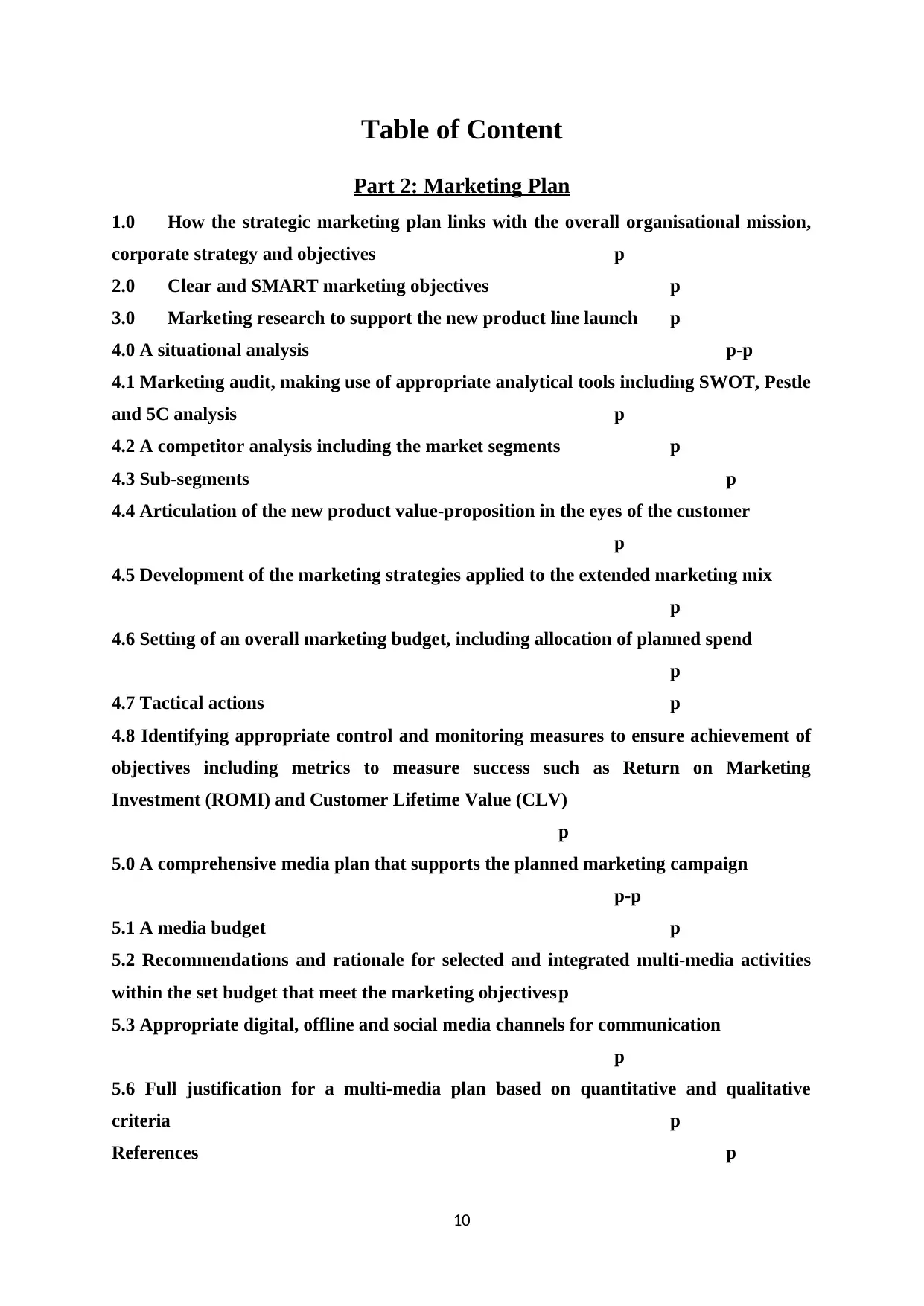
Table of Content
Part 2: Marketing Plan
1.0 How the strategic marketing plan links with the overall organisational mission,
corporate strategy and objectives p
2.0 Clear and SMART marketing objectives p
3.0 Marketing research to support the new product line launch p
4.0 A situational analysis p-p
4.1 Marketing audit, making use of appropriate analytical tools including SWOT, Pestle
and 5C analysis p
4.2 A competitor analysis including the market segments p
4.3 Sub-segments p
4.4 Articulation of the new product value-proposition in the eyes of the customer
p
4.5 Development of the marketing strategies applied to the extended marketing mix
p
4.6 Setting of an overall marketing budget, including allocation of planned spend
p
4.7 Tactical actions p
4.8 Identifying appropriate control and monitoring measures to ensure achievement of
objectives including metrics to measure success such as Return on Marketing
Investment (ROMI) and Customer Lifetime Value (CLV)
p
5.0 A comprehensive media plan that supports the planned marketing campaign
p-p
5.1 A media budget p
5.2 Recommendations and rationale for selected and integrated multi-media activities
within the set budget that meet the marketing objectivesp
5.3 Appropriate digital, offline and social media channels for communication
p
5.6 Full justification for a multi-media plan based on quantitative and qualitative
criteria p
References p
10
Part 2: Marketing Plan
1.0 How the strategic marketing plan links with the overall organisational mission,
corporate strategy and objectives p
2.0 Clear and SMART marketing objectives p
3.0 Marketing research to support the new product line launch p
4.0 A situational analysis p-p
4.1 Marketing audit, making use of appropriate analytical tools including SWOT, Pestle
and 5C analysis p
4.2 A competitor analysis including the market segments p
4.3 Sub-segments p
4.4 Articulation of the new product value-proposition in the eyes of the customer
p
4.5 Development of the marketing strategies applied to the extended marketing mix
p
4.6 Setting of an overall marketing budget, including allocation of planned spend
p
4.7 Tactical actions p
4.8 Identifying appropriate control and monitoring measures to ensure achievement of
objectives including metrics to measure success such as Return on Marketing
Investment (ROMI) and Customer Lifetime Value (CLV)
p
5.0 A comprehensive media plan that supports the planned marketing campaign
p-p
5.1 A media budget p
5.2 Recommendations and rationale for selected and integrated multi-media activities
within the set budget that meet the marketing objectivesp
5.3 Appropriate digital, offline and social media channels for communication
p
5.6 Full justification for a multi-media plan based on quantitative and qualitative
criteria p
References p
10
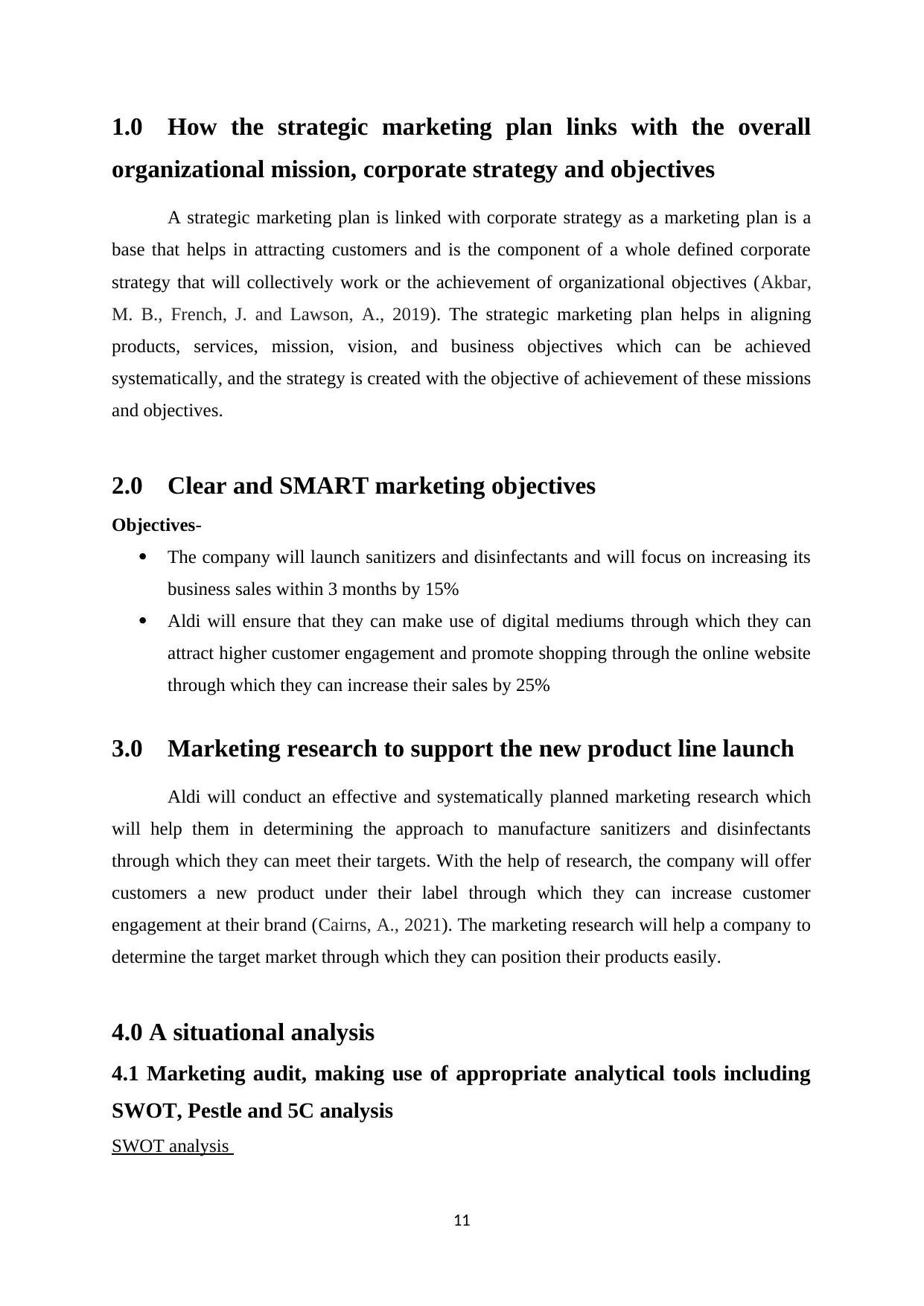
1.0 How the strategic marketing plan links with the overall
organizational mission, corporate strategy and objectives
A strategic marketing plan is linked with corporate strategy as a marketing plan is a
base that helps in attracting customers and is the component of a whole defined corporate
strategy that will collectively work or the achievement of organizational objectives (Akbar,
M. B., French, J. and Lawson, A., 2019). The strategic marketing plan helps in aligning
products, services, mission, vision, and business objectives which can be achieved
systematically, and the strategy is created with the objective of achievement of these missions
and objectives.
2.0 Clear and SMART marketing objectives
Objectives-
The company will launch sanitizers and disinfectants and will focus on increasing its
business sales within 3 months by 15%
Aldi will ensure that they can make use of digital mediums through which they can
attract higher customer engagement and promote shopping through the online website
through which they can increase their sales by 25%
3.0 Marketing research to support the new product line launch
Aldi will conduct an effective and systematically planned marketing research which
will help them in determining the approach to manufacture sanitizers and disinfectants
through which they can meet their targets. With the help of research, the company will offer
customers a new product under their label through which they can increase customer
engagement at their brand (Cairns, A., 2021). The marketing research will help a company to
determine the target market through which they can position their products easily.
4.0 A situational analysis
4.1 Marketing audit, making use of appropriate analytical tools including
SWOT, Pestle and 5C analysis
SWOT analysis
11
organizational mission, corporate strategy and objectives
A strategic marketing plan is linked with corporate strategy as a marketing plan is a
base that helps in attracting customers and is the component of a whole defined corporate
strategy that will collectively work or the achievement of organizational objectives (Akbar,
M. B., French, J. and Lawson, A., 2019). The strategic marketing plan helps in aligning
products, services, mission, vision, and business objectives which can be achieved
systematically, and the strategy is created with the objective of achievement of these missions
and objectives.
2.0 Clear and SMART marketing objectives
Objectives-
The company will launch sanitizers and disinfectants and will focus on increasing its
business sales within 3 months by 15%
Aldi will ensure that they can make use of digital mediums through which they can
attract higher customer engagement and promote shopping through the online website
through which they can increase their sales by 25%
3.0 Marketing research to support the new product line launch
Aldi will conduct an effective and systematically planned marketing research which
will help them in determining the approach to manufacture sanitizers and disinfectants
through which they can meet their targets. With the help of research, the company will offer
customers a new product under their label through which they can increase customer
engagement at their brand (Cairns, A., 2021). The marketing research will help a company to
determine the target market through which they can position their products easily.
4.0 A situational analysis
4.1 Marketing audit, making use of appropriate analytical tools including
SWOT, Pestle and 5C analysis
SWOT analysis
11
⊘ This is a preview!⊘
Do you want full access?
Subscribe today to unlock all pages.

Trusted by 1+ million students worldwide
1 out of 19
Related Documents
Your All-in-One AI-Powered Toolkit for Academic Success.
+13062052269
info@desklib.com
Available 24*7 on WhatsApp / Email
![[object Object]](/_next/static/media/star-bottom.7253800d.svg)
Unlock your academic potential
Copyright © 2020–2025 A2Z Services. All Rights Reserved. Developed and managed by ZUCOL.



